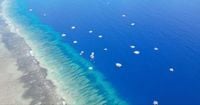The waters surrounding Scarborough Shoal, a small but fiercely contested atoll in the South China Sea, have once again become the stage for a high-profile display of Chinese authority. On October 1, 2025, the China Coast Guard (CCG) marked the country’s National Day by holding a flag-raising ceremony aboard the patrol vessel Dahao (3304), anchored close to the disputed shoal. The event, which was broadcast on Chinese state television and posted on Douyin (the Chinese version of TikTok), featured coast guard officers standing in formation, saluting the national flag as it was hoisted over the blue expanse. The ceremony was heavy with symbolism and intent, underscoring Beijing’s determination to assert its claims over the atoll, known in China as Huangyan Dao and in the Philippines as Panatag Shoal.
According to South China Morning Post and Reuters, the video’s subtitles declared: “We stand guard over these blue waters, assuring the nation of our unwavering commitment.” In a separate National Day message aired by CCTV, CCG officer Chen Zhijie described the task of protecting the disputed island as his “sacred duty and glorious mission,” pledging to “perform our duties conscientiously and contribute our utmost to protecting our country’s territorial sovereignty.” The event was not just a celebration, but a clear message to both domestic and international audiences that China intends to maintain—and indeed, reinforce—its presence at Scarborough Shoal.
Scarborough Shoal is a triangular atoll located about 222 kilometers west of the Philippines’ Luzon island. Both China and the Philippines claim the feature, but since a tense standoff in 2012, China has maintained de facto control, keeping a steady deployment of coast guard ships and fishing trawlers in the area. The shoal’s strategic location in the busy South China Sea shipping lanes, along with its rich marine resources, has made it a persistent flashpoint for diplomatic tensions and maritime encounters between the two countries.
Recent years have seen an uptick in confrontations. As reported by Reuters and Global Times, incidents have included the use of water cannons, boat-ramming, and dangerously close maneuvers by Chinese coast guard vessels—actions the Philippines has repeatedly condemned as provocative. In one particularly embarrassing episode, two Chinese vessels collided with each other while in pursuit of a Philippine Coast Guard patrol ship, just 10.5 nautical miles east of the shoal. Although Beijing has not formally acknowledged the mishap, it has since moved to strengthen its patrols and further cement its grip on the area.
The flag-raising event came on the heels of another contentious move by Beijing: the approval, in September 2025, of a national nature reserve at Scarborough Shoal. China’s National Forestry and Grassland Administration announced that the reserve would span more than 3,500 hectares, aimed at protecting the atoll’s fragile coral reef ecosystem. On paper, the initiative sounds like a step toward environmental stewardship. But as reported by South China Morning Post and The Hindu, many observers—including international legal experts and regional analysts—see the designation as a thinly veiled attempt to reinforce China’s territorial claims.
“Experts say China’s establishment of a nature reserve in the area is a territorial move rather than an environmental one, designed to bolster its claims of sovereignty,” The Hindu reported. This skepticism is not without precedent. In 2016, the Permanent Court of Arbitration in The Hague ruled that Beijing’s blockade of the shoal was unlawful under international law, recognizing Scarborough as a traditional fishing ground for several countries, including the Philippines and Vietnam. China, however, has refused to accept the tribunal’s decision, pressing ahead with its expansive claims and routine patrols.
The Philippines has responded with strong protests. As stated by Philippine officials and reported by South China Morning Post, Manila insists that Scarborough Shoal “is a longstanding and integral part of the Philippines over which it has sovereignty and jurisdiction.” The Philippine government maintains that it alone has the “exclusive authority to establish environmental protection areas over its territory and relevant maritime zones.” The establishment of the Chinese nature reserve, therefore, is seen in Manila not as an environmental gesture but as a direct challenge to Philippine sovereignty.
Chinese officials and aligned experts have not shied away from signaling further escalation. Zhang Yancang, director of the Yellow Sea and Bohai Sea Research Institute at Dalian Maritime University, told CCTV that patrols around the shoal would become “routine and regular,” with daily presence not only by coastguard vessels but also aircraft, drones, and even uncrewed boats. Wu Shicun, a prominent think-tanker from the National Institute for South China Sea Studies, floated the possibility that China might eventually build an artificial island at Scarborough Shoal “if it serves to strengthen China’s assertion of sovereignty and effective administrative control.” Such a move would likely inflame tensions even further, as large-scale land reclamation would undermine any pretense of environmental protection and signal a dramatic escalation in China’s campaign for control.
Despite the heightened rhetoric and increased patrols, the standoff at Scarborough Shoal has not yet resulted in armed conflict. Both sides accuse each other of trespassing and provocation, but so far, the clashes have remained at the level of maritime maneuvering and diplomatic protest. The Philippine Coast Guard, for its part, has repeatedly challenged the presence of Chinese vessels—specifically noting the patrol vessel Dahao (3304)—for what it calls “illegal presence” at the shoal.
Meanwhile, the broader context remains fraught. Scarborough Shoal is but one of several disputed features in the South China Sea, a region where overlapping claims by China, the Philippines, Vietnam, and other Southeast Asian nations have led to decades of tension and occasional confrontation. The international community, while recognizing the 2016 arbitration ruling, has been largely unable to compel China to alter its behavior. For Beijing, the National Day ceremony and the establishment of a nature reserve are part of a broader strategy to normalize its control and present its presence as both routine and legitimate.
For Filipino fishermen and local communities, the situation remains precarious. Scarborough Shoal has traditionally served as a rich fishing ground, and access restrictions imposed by Chinese patrols have had real economic and social impacts. The ongoing tug-of-war over the atoll is not just a matter of grand strategy or national pride—it has tangible consequences for the livelihoods of those who depend on the sea.
As the South China Sea dispute continues to simmer, the flag-raising ceremony at Scarborough Shoal stands as a potent reminder of how symbols, law, and daily realities collide in contested waters. The atoll’s fate, and that of those who rely on it, remains uncertain—caught between the ambitions of powerful states and the enduring pull of history and geography.

